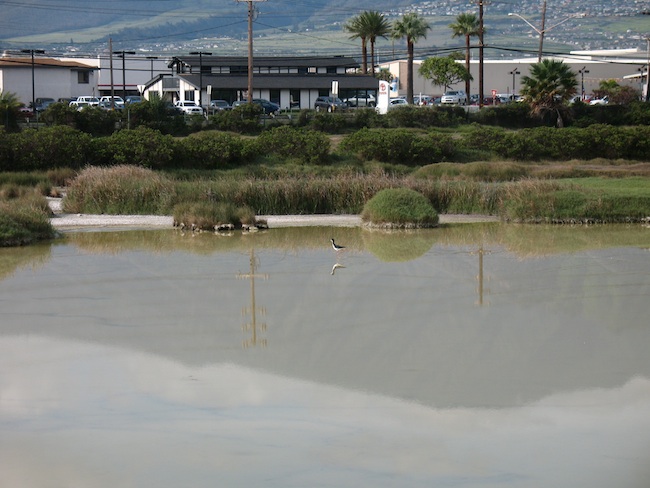I’m not sure if I’ve mentioned this before, but the West Maui mountains creep me out. They’re intermediate in erosion between the massive-yet-pimpled with cinder cones peaks (Mauna Kea, Hualalai, and Haleakalā) and the deeply eroded ranges found on O’ahu and Kaua’i. I just find West Maui too pointy- like it’s obviously just beginning to be dissected into sharp edges, but before it’s been softened into fluted valleys and gentle hills.

…but I digress. I intended in this post to talk about a few birding sites on Maui that are easily accessible, in lowland areas. We visited both of these locations in December 2010.
The above photo is from one of those sites, a wildlife sanctuary called Kanahā Pond. This sight is literally just down the street from the Wailuku Kahului airport, so it was our first stop when we got in to Maui. While it backs onto a business/industrial area, it’s one of the largest (and few remaining) wetland sites on Maui. It harbors a large number of migratory species, as well as four of the ‘big five’ breeding waterfowl: the endemic Hawaiian Coot (endangered species), endemic Hawaiian Moorhen (endangered subspecies of the Common Moorhen), endemic Hawaiian Stilt (endangered subspecies of the Black-Necked Stilt), and the native Black-crowned Night-Heron. The endangered Hawaiian Duck is not found here, though some of the Mallards seen here might be hybrids with this species.

If you’re into birding, this is definitely a good location to check out- if you’re not a birder, why not park it here for a while with a snack or beverage from a nearby shop and check out the action? Species we saw: Laughing Gull, Stilt, Cattle Egret, Myna, Night-Heron, Spotted Dove, House Sparrow, Pacific Golden-Plover, Coot, and Red-Crested Cardinal.

The other wetland site that’s easily accessible on Maui is Kealia Pond, a National Wildlife refuge on the south shore of the isthmus. You can do more walking around here. There are two entrances to this site. One parking area, along the shoreline off of Kihei Rd/Hwy 310, gives access to the beach and a boardwalk with interpretive signage. This is the nicer location. The other access point, off of Hwy 311/Mokulele Rd, is less aesthetically pleasing (i.e., muddy and full of midges), but much better for birding.
You can access the pond itself via a series of berms that you can walk along. When we were there, it was quite muddy. The midges don’t bite, but they will swarm all over you- this was distracting and oogy for us, and would probably be really creepy if you have a problem with insects.

You can see a much larger part of the pond here than at Kanahā Pond, but that also means the birds can see you and be startled. We saw quite a few more species here: American Wigeon, Zebra Dove, Stilt, Cattle Egret, Chestnut Munia, Myna, Coot, Least Sandpiper, Mallard, Northern Cardinal, Northern Pintail, Northern Shoveler, Orange-cheeked Waxbill, Pacific Golden-Plover, Ring-billed Gull, Sanderling, White-faced Ibis, and Night-Heron. I also saw a goose, which flew away before I could make a positive i.d.- possibly a White-fronted goose. I’d definitely recommend this site for those interested in birds.
So, two good lowland wetland birding sites on Maui. I have one more Maui post planned, then I’ll be moving on to other topics.
One reply on “Lowland birding on Maui”
[…] one that was hanging out at OWP last spring, I did end up unexpectedly seeing several of them on Maui a few months later. And that was pretty cool- they’re pretty uncommon in the Hawaiian […]